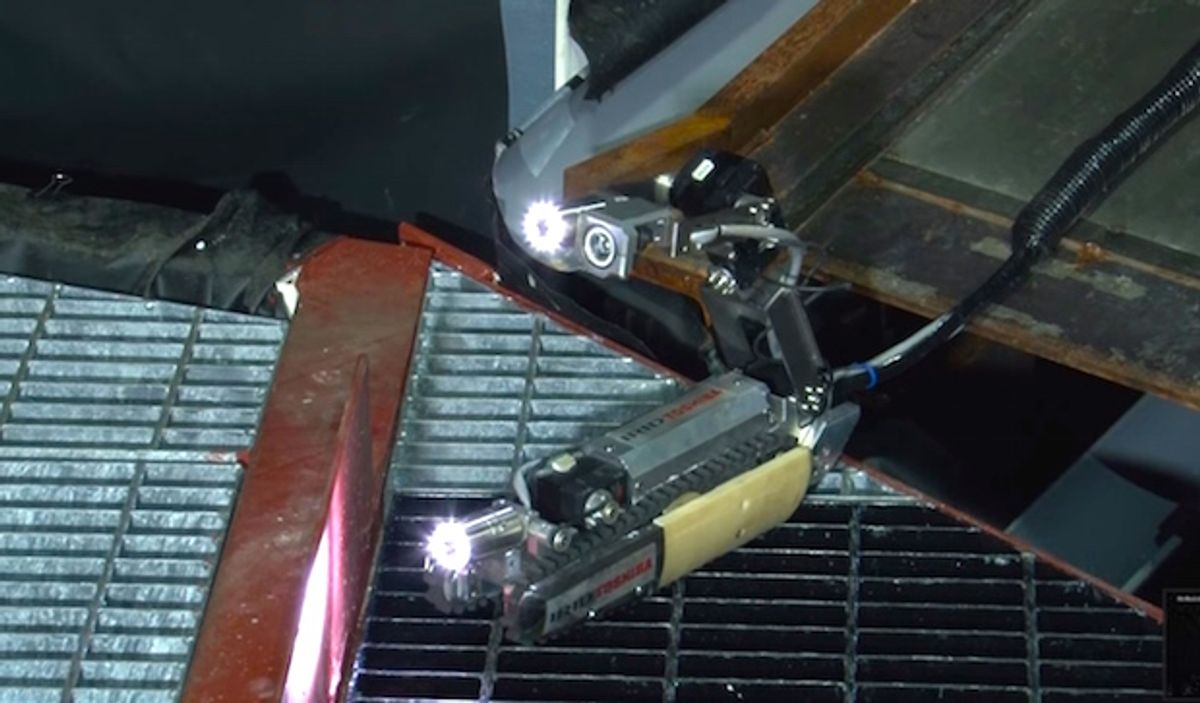The search is still on for the melted fuel that is, hopefully, sitting in a death puddle somewhere at the bottom of Fukushima’s damaged nuclear reactors. After two snake robots, designed by Hitachi, explored the Unit 1 reactor back in April (with one of the robots getting stuck), the next expedition goes to Toshiba, with a “scorpion” design that will enter Unit 2 at the end of August. Hopefully it’ll work, but what this situation really needs is a modular, reconfigurable robot. Here’s why.
In order to get down into the shattered interior of the Unit 2 reactor, where an interior detonation is thought to have caused severe damage, robots must be fed through a narrow duct and even go over a gap between two platforms. To do that, a robot by necessity must be long and skinny, hence Hitachi’s snake design. Toshiba’s robot, designed in collaboration with Japan’s International Research Institute for Nuclear Decommissioning (IRID), is trying something slightly different, with a liftable tail that it can bring up and around over its body:
The robot is 54 centimeters long, and is radiation hardened to be able to operate inside the reactor for at least 10 hours.
Now, there’s nothing wrong with this design, but it seems clear that its adaptability is severely limited, because of the constraints imposed by the entry point. Those tracks, for example, don’t look like they’d be very good at dealing with much in the way of debris, but there’s simply not enough room to make them significantly bigger or more robust. And although the robot has been radiation hardened, when an important component gets fried (and an important component will, eventually, get fried), it’s done.
Thirteen years ago, Mark Yim, Ying Zhang, and David Duff wrote an article for us about the advantages of modular, reconfigurable, adaptable robots. Modular robotics has been hypothetically useful for decaudes, but this, right here, is a real-world use case where modular robots could be invaluable. This is the moment where all those “this robot could potentially be used in disaster areas” rationalizations that you find in grant proposals or at the ends of papers might actually pay off: a situation in which a robot that can disassemble into pieces, or adaptively reconfigure itself on the fly, could be better and faster than any traditional design. Plus, you’ve got an extraordinarily harsh environment, where radiation will start causing your robot serious problems in a matter of hours, in which case having the ability to adapt—by changing shape or behavior to deal with a damaged components, for example—could significantly extend the useful life of your robot.
To be sure, there’s an enormous amount of work that would have to be done to transition modular or adaptive robots from research into real world applications. So at this point, it’s unrealistic to make any sort of demand on a technology that’s still under active development. But it would be great to have something to point to and say, “See? You know all that crazy robot research? This is why it’s important.”
[ Toshiba ] via [ AP ]
Evan Ackerman is a senior editor at IEEE Spectrum. Since 2007, he has written over 6,000 articles on robotics and technology. He has a degree in Martian geology and is excellent at playing bagpipes.



